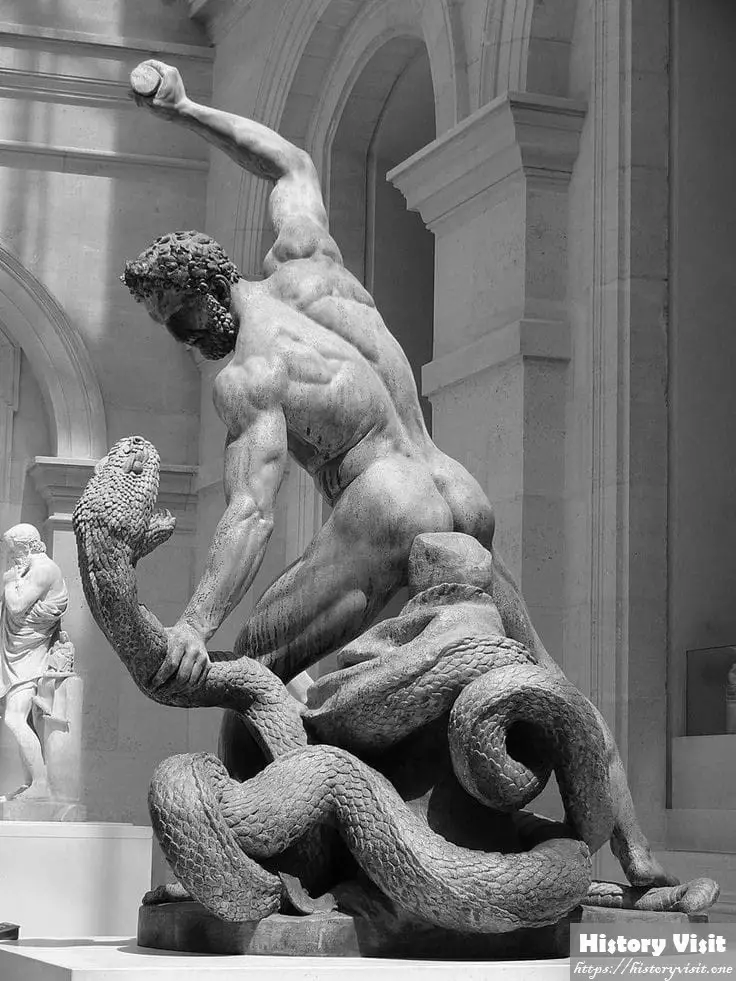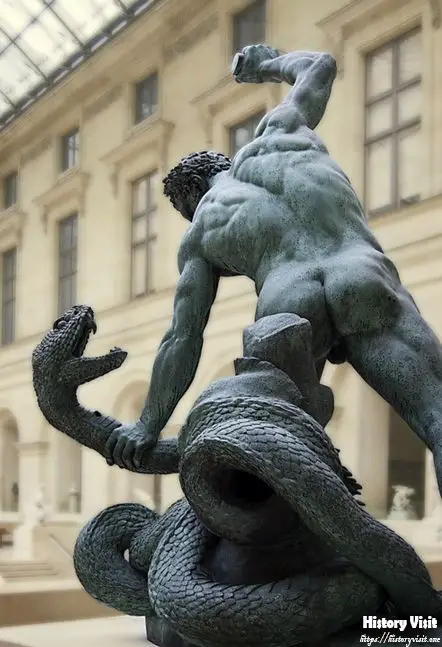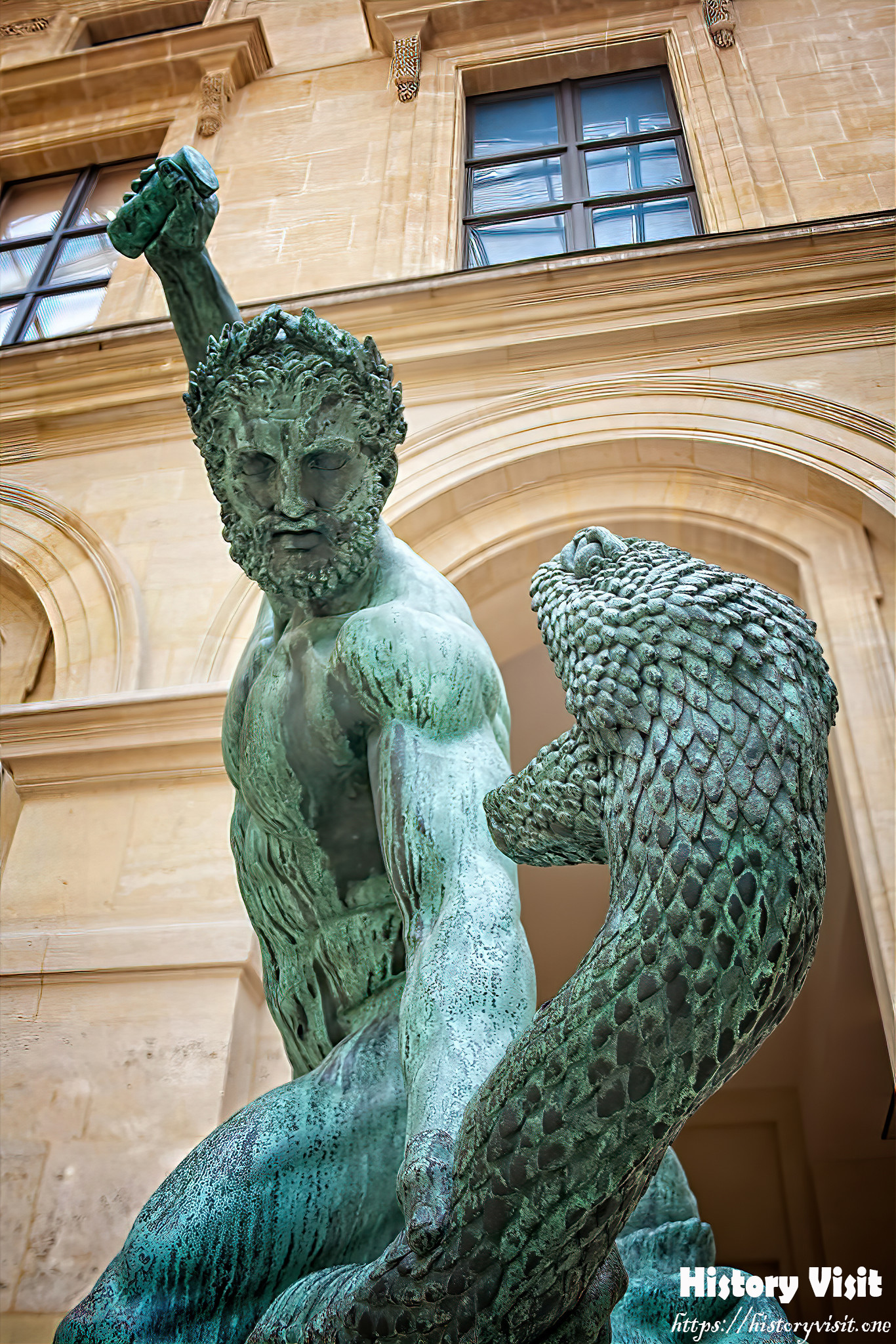Hercules and the Hydra : Uncover the Secrets of Bosio’s Epic !

Introduction of Hercules and the Hydra
In the vast expanse of 19th-century sculpture, François Joseph Bosio’s “Hercules and the Lernaean Hydra” stands as a monumental achievement. Created in 1824, this masterpiece encapsulates the essence of heroism, struggle, and triumph that defines the legend of Hercules. Bosio, a renowned Neoclassical sculptor, masterfully brings to life one of the most iconic myths of ancient Greece, capturing the ferocity of the Hydra and the unwavering determination of Hercules in a single, breathtaking composition.
François Joseph Bosio was not merely a sculptor but a storyteller who used marble and bronze as his mediums. His work on “Hercules and the Lernaean Hydra” reflects his deep understanding of both classical mythology and human emotion, making it a timeless piece that continues to resonate with audiences today. The sculpture is not just a depiction of a mythological event but a profound exploration of themes such as perseverance, strength, and the eternal battle between good and evil.
This article delves into the intricate details of Bosio’s “Hercules and the Lernaean Hydra,” examining the historical context, technical mastery, and symbolic depth of the sculpture. Through this analysis, we aim to uncover the layers of meaning embedded in this iconic artwork and appreciate the genius of François Joseph Bosio.
François Joseph Bosio: The Sculptor
François Joseph Bosio was born on March 19, 1768, in Monaco. From a young age, Bosio exhibited a keen interest in the arts, which led him to Paris to study under the tutelage of the prominent sculptor Augustin Pajou. This formative period in Bosio’s life was crucial in shaping his artistic vision and honing his technical skills. Pajou, known for his Neoclassical style, had a significant influence on Bosio, instilling in him a reverence for classical antiquity that would pervade his later works.
Bosio’s career flourished in the politically tumultuous landscape of post-Revolutionary France. His ability to adapt to the changing tastes and demands of his patrons, from the Napoleonic regime to the Bourbon Restoration, allowed him to maintain prominence and secure prestigious commissions. In 1816, he was appointed as the official court sculptor for Louis XVIII, a position that solidified his reputation as one of the leading sculptors of his time.
Throughout his career, Bosio’s work was characterized by a meticulous attention to detail and a profound understanding of human anatomy and emotion. His sculptures, ranging from grand public monuments to intimate portrait busts, demonstrated his versatility and mastery of the medium. “Hercules and the Lernaean Hydra,” created in 1824, is a testament to Bosio’s skill and artistic vision, embodying the principles of Neoclassicism while infusing the mythological subject with dynamic energy and emotional depth.
The Myth of Hercules and the Lernaean Hydra

The story of Hercules and the Lernaean Hydra is one of the most famous myths of ancient Greece, forming part of the twelve labors that Hercules was tasked with completing. According to the myth, the Hydra was a fearsome serpent-like creature with multiple heads, residing in the swamps of Lerna. Each time Hercules decapitated one of its heads, two more would grow back in its place, making the creature nearly invincible. Adding to the Hydra’s menace, one of its heads was immortal, and its breath and blood were highly poisonous.
This labor was assigned to Hercules by King Eurystheus, who sought to humiliate and ultimately destroy the hero through these seemingly impossible tasks. To defeat the Hydra, Hercules enlisted the help of his nephew Iolaus. Following Athena’s guidance, Iolaus used a blazing torch to cauterize each neck stump as Hercules decapitated the heads, preventing them from regenerating. Finally, Hercules severed the immortal head and buried it under a massive rock, securing his victory over the monstrous creature.
The myth of the Lernaean Hydra is rich in symbolic meaning, representing the challenges and adversities that must be overcome through ingenuity, perseverance, and strength. For centuries, this story has captivated the imagination of artists, writers, and thinkers, serving as a potent metaphor for the human condition. Bosio’s sculpture brings this timeless tale to life, capturing the dramatic struggle and ultimate triumph of Hercules in his battle against the Hydra.
The Sculpture: Detailed Examination
Bosio’s “Hercules and the Lernaean Hydra” is a remarkable feat of artistry and craftsmanship. The sculpture is typically rendered in marble, a medium that allows for exquisite detail and a lifelike representation of the figures. The composition is dynamic, with Hercules depicted in the midst of his struggle against the Hydra, embodying both physical strength and heroic determination. The interaction between the hero and the monster is charged with tension, creating a sense of movement and drama that draws the viewer into the narrative.
The sculpture portrays Hercules in a powerful stance, muscles tensed and body coiled in a display of raw strength and energy. His expression is one of intense focus and determination, reflecting the gravity of the battle. The Hydra, with its multiple serpentine heads, is rendered with a sense of menace and fluidity, emphasizing the creature’s otherworldly nature. Bosio’s attention to anatomical detail is evident in the intricate depiction of the Hydra’s scales and the sinewy musculature of Hercules, lending a sense of realism to the mythological scene.
One of the most striking aspects of Bosio’s sculpture is its use of space and composition. The figures are arranged in a dynamic interplay, with the Hydra’s serpentine bodies encircling Hercules in a chaotic yet controlled manner. This creates a visual rhythm that guides the viewer’s eye across the sculpture, highlighting the intense struggle and the hero’s eventual triumph. The contrast between Hercules’ solid, grounded form and the fluid, twisting shapes of the Hydra enhances the dramatic impact of the scene.
Artistic Techniques and Innovations
François Joseph Bosio’s “Hercules and the Lernaean Hydra” showcases his mastery of Neoclassical techniques while also introducing innovative elements that set his work apart from his contemporaries. Neoclassicism, which drew inspiration from the art and culture of ancient Greece and Rome, emphasized clarity of form, idealized beauty, and a sense of harmony and balance. Bosio adhered to these principles but also infused his sculpture with a dynamic energy and emotional intensity that brought the mythological scene to life.
One of the key techniques employed by Bosio is his meticulous attention to detail. The sculpture’s intricate rendering of anatomical features, such as the bulging muscles of Hercules and the textured scales of the Hydra, demonstrates Bosio’s deep understanding of the human and animal form. This level of detail not only adds to the realism of the sculpture but also enhances its expressive power, allowing viewers to appreciate the physical and emotional strain of the battle.
Bosio also made innovative use of movement and composition to create a sense of drama and immediacy. Unlike many Neoclassical sculptures that favored static, posed figures, “Hercules and the Lernaean Hydra” is full of dynamic action. Hercules is depicted in mid-motion, his body twisting and muscles straining as he grapples with the Hydra. This sense of movement is further accentuated by the serpentine coils of the Hydra, which encircle and entwine with Hercules in a visually engaging and complex arrangement.
Additionally, Bosio’s use of light and shadow plays a crucial role in enhancing the sculpture’s impact. The careful carving of the marble allows for subtle gradations of light and shadow, which highlight the contours and textures of the figures. This technique not only adds depth and dimension to the sculpture but also helps to convey the intensity of the struggle between Hercules and the Hydra. Bosio’s innovative approach to composition, movement, and light sets “Hercules and the Lernaean Hydra” apart as a masterpiece of Neoclassical sculpture.
Symbolic and Thematic Analysis

At its core, “Hercules and the Lernaean Hydra” is a powerful exploration of universal themes such as heroism, perseverance, and the triumph of good over evil. Through his depiction of Hercules’ battle with the Hydra, Bosio delves into the deeper symbolic meanings of the myth, creating a work that resonates on both an aesthetic and an intellectual level.
The figure of Hercules has long been a symbol of strength and resilience, embodying the virtues of courage and determination. In Bosio’s sculpture, Hercules is depicted not merely as a warrior but as a hero engaged in a profound struggle against seemingly insurmountable odds. His determined expression and powerful stance convey a sense of inner resolve, emphasizing the mental and emotional fortitude required to overcome great challenges. This portrayal of Hercules as a figure of both physical and moral strength serves as an inspiring reminder of the potential for human achievement and the capacity to conquer adversity.
The Hydra, on the other hand, represents chaos, danger, and the unknown. Its multiple heads and serpentine form evoke a sense of otherworldly menace, symbolizing the many-headed nature of life’s difficulties and the persistent threats that can arise from unexpected quarters. By portraying Hercules in the act of subduing the Hydra, Bosio underscores the theme of victory through perseverance and ingenuity. The use of fire to cauterize the Hydra’s neck stumps, preventing them from regenerating, symbolizes the power of knowledge and strategy in overcoming brute force.
Moreover, the sculpture can be seen as a reflection of the human condition and the eternal struggle between good and evil. Hercules’ battle with the Hydra is not just a physical confrontation but a moral and existential one, representing the broader conflicts that define the human experience. The themes of struggle, sacrifice, and eventual triumph resonate with audiences across time and cultures, making Bosio’s sculpture a timeless and universal work of art.
Critical Reception and Historical Impact
When “Hercules and the Lernaean Hydra” was unveiled in 1824, it was met with widespread acclaim from both critics and the public. Bosio’s ability to capture the dynamism and intensity of the mythological battle impressed contemporaries, who praised the sculpture for its technical excellence and emotional depth. The work was seen as a testament to Bosio’s skill as a sculptor and his ability to breathe new life into classical themes.
The sculpture’s success further cemented Bosio’s reputation as one of the leading artists of his time. His appointment as the official court sculptor for Louis XVIII had already established him as a prominent figure in the art world, and “Hercules and the Lernaean Hydra” only served to enhance his standing. The work was celebrated not only for its artistic merit but also for its embodiment of Neoclassical ideals, which were highly valued in the cultural climate of early 19th-century France.
In the years following its creation, “Hercules and the Lernaean Hydra” continued to influence and inspire other artists. Bosio’s innovative approach to movement, composition, and emotional expression set a new standard for Neoclassical sculpture, encouraging other sculptors to explore similar themes and techniques. The work also contributed to a renewed interest in classical mythology, which became a popular subject for artists across various mediums.
The historical impact of “Hercules and the Lernaean Hydra” extends beyond its immediate reception and influence on other artists. The sculpture has been preserved and displayed in various museums and galleries, allowing generations of viewers to appreciate its beauty and significance. It serves as a lasting testament to the enduring power of classical mythology and the artistic genius of François Joseph Bosio.
Conclusion of Hercules and Hydra
François Joseph Bosio’s “Hercules and the Lernaean Hydra” is a masterpiece that transcends time and place, capturing the essence of heroism, struggle, and triumph in a single, breathtaking composition. Created in 1824, this sculpture stands as a testament to Bosio’s skill and artistic vision, embodying the principles of Neoclassicism while infusing the mythological subject with dynamic energy and emotional depth. Through his meticulous attention to detail and innovative use of movement and composition, Bosio brings to life the timeless story of Hercules’ battle with the Hydra, creating a work that resonates on both an aesthetic and intellectual level.
The sculpture not only reflects the universal themes of perseverance, strength, and the eternal struggle between good and evil but also serves as a profound exploration of the human condition. Hercules’ determined expression and powerful stance, combined with the menacing presence of the Hydra, convey a sense of inner resolve and the capacity to conquer adversity. This portrayal of the hero’s journey and ultimate triumph serves as an inspiring reminder of the potential for human achievement and the power of knowledge and strategy in overcoming great challenges.
“Hercules and the Lernaean Hydra” continues to inspire and captivate audiences, preserving its relevance and significance through the centuries. As a work of art, it stands as a testament to François Joseph Bosio’s artistic genius and his ability to breathe new life into classical themes. As we continue to explore and appreciate this masterpiece, we are reminded of the enduring power of mythology and the timeless appeal of stories that speak to the deepest aspects of the human experience.
These is the another snake Sculpture ‘MAN FIGHTING A SNAKE’ by Gabriel Jules Thomas.


